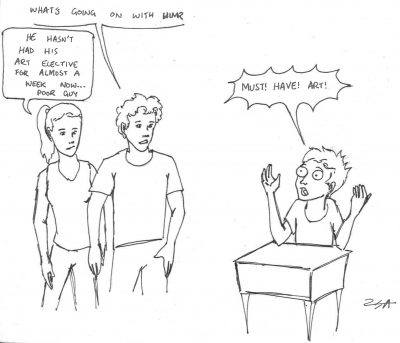
In grades 7 and 8, art and drama are offered as possible electives, meeting three days out of the eight-day cycle. The infrequency of these classes poses problems and restrictions both for students who have an interest in art and drama and those who are less inclined to art and drama.
As students do not have the final say in which elective they are granted, students who have a real desire to take art and drama courses may actually be denied the opportunity to pursue art and drama courses in the selection process. This restricts students from delving deeper into their interests and discovering whether this is something that they should move forward with. Compulsory art and drama classes also allow students who pursue art and drama outside of school to be granted in-school opportunities to practice these skills.
Additionally, since these courses are not mandatory, students who do not have an interest in art and drama aren’t forced to attempt these art forms, hence depriving them of skills which could be acquired from such classes. This does not allow or encourage students to try new things which are out of their comfort zones and that could even become a passion.
Art and drama being only electives result in our school’s curriculum being not diverse and practical. Art and drama have the potential to be helpful to students who are visual learners, because it’s a better and different way of learning for them. They can learn about subjects traditionally taught in academic classes through art. Communication skills are one key area that drama classes will have the ability to hone, as students are forced to collaborate with other students to create a successful production.
The middle school visual arts teacher Mr. Domingo Martinez agrees about the importance of art education for students. “Art courses (drawing, painting, photography, video, 3D art, etc.) comprise learning art skills” at the same time as dealing with broader issues or themes such as diversity, social injustice, identity, gender inequality, social conflicts, history, etc. This means that students can learn about any other subjects in art classes, explained Mr. Martinez.
Additionally, art and drama allow students to express themselves in a way that is different from other non-elective classes. Art and drama have the ability to push students’ boundaries because it requires them to experiment with their creativity. Moreover, art and drama are platforms which give students a voice to express their thoughts. It can be especially beneficial for introverted students who find it difficult to express their thoughts to the masses. Art and drama can serve as an outlet for many students. Students may find that art and drama as potential outlets where they can let loose and express themselves in the most creative ways. Through art and drama, our thoughts and emotions about life’s experiences may be expressed.
Students in the ASL community also agreed about the benefits of drama if it became more than just an elective. “Drama is fun and a good way to encourage creativity and passion. In my opinion, drama helps boost self-confidence and public speaking, along with concentration. With all of the games and acting, you have to concentrate and focus which could help you in class and outside of school as well,” seventh grader Grace Hamilton said. She also added that drama and art provide students with “a healthy break” throughout the day.
Art and drama classes allow students to approach issues that they have to deal with in a new, creative way. It works a different part of your brain which will allow students to be better problem-solvers, inventors, and collaborators in our world. Finally, art and drama classes may be the grounds where potential creative masterminds who can greatly contribute to our world are discovered.
Art and drama should become more than an elective because of the endless benefits that it can have on students. Should art and drama become more than an elective, this would mean a brighter future for our world as students will be able to solve, invent and accomplish the unthinkable.
